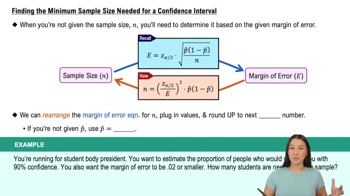Table of contents
- 1. Intro to Stats and Collecting Data55m
- 2. Describing Data with Tables and Graphs1h 55m
- 3. Describing Data Numerically1h 45m
- 4. Probability2h 16m
- 5. Binomial Distribution & Discrete Random Variables2h 33m
- 6. Normal Distribution and Continuous Random Variables1h 38m
- 7. Sampling Distributions & Confidence Intervals: Mean1h 3m
- 8. Sampling Distributions & Confidence Intervals: Proportion1h 12m
- 9. Hypothesis Testing for One Sample1h 1m
- 10. Hypothesis Testing for Two Samples2h 8m
- 11. Correlation48m
- 12. Regression1h 4m
- 13. Chi-Square Tests & Goodness of Fit1h 20m
- 14. ANOVA1h 0m
1. Intro to Stats and Collecting Data
Intro to Stats
Problem 1.C.5
Textbook Question
Determining Sample Size The given expression is used to determine the size of the sample necessary to estimate the proportion of college students who have the profound wisdom to take a statistics course. Find the value and round the result up to the next larger whole number.
[(1.95996)^2 - 0.25] / (0.03)^2
 Verified step by step guidance
Verified step by step guidance1
Identify the formula for determining the sample size for estimating a proportion, which is given by: \( n = \frac{Z^2 \cdot p \cdot (1-p)}{E^2} \), where \( Z \) is the Z-score, \( p \) is the estimated proportion, and \( E \) is the margin of error.
Recognize that the expression provided is a simplified version of the sample size formula, where \( Z = 1.95996 \), \( p = 0.5 \) (since \( 0.25 = 0.5 \times 0.5 \)), and \( E = 0.03 \).
Substitute the given values into the formula: \( n = \frac{(1.95996)^2 \cdot 0.5 \cdot 0.5}{(0.03)^2} \).
Calculate the numerator: \( (1.95996)^2 \cdot 0.5 \cdot 0.5 \).
Calculate the denominator: \( (0.03)^2 \), then divide the numerator by the denominator and round up to the next whole number to find the required sample size.
 Verified video answer for a similar problem:
Verified video answer for a similar problem:This video solution was recommended by our tutors as helpful for the problem above
Video duration:
1mPlay a video:
Was this helpful?
Key Concepts
Here are the essential concepts you must grasp in order to answer the question correctly.
Sample Size Determination
Sample size determination is a statistical process used to calculate the number of observations or replicates needed in a study to achieve a desired level of precision. It ensures that the sample accurately reflects the population, minimizing errors and increasing the reliability of the results. In this context, it involves using a formula to estimate the proportion of a population with a specific characteristic.
Recommended video:

Sampling Distribution of Sample Proportion
Confidence Level and Z-Score
The confidence level represents the degree of certainty that the population parameter lies within the confidence interval. A Z-score is a statistical measurement that describes a value's relation to the mean of a group of values, often used in the context of confidence intervals. In the given expression, 1.95996 is the Z-score corresponding to a 95% confidence level, indicating the range within which the true population proportion is expected to fall.
Recommended video:

Critical Values: z Scores
Margin of Error
The margin of error is a statistic expressing the amount of random sampling error in a survey's results. It defines the range within which the true population parameter is expected to lie, with a certain level of confidence. In the formula, 0.03 represents the desired margin of error, indicating the acceptable range of deviation from the true proportion of students taking a statistics course.
Recommended video:

Finding the Minimum Sample Size Needed for a Confidence Interval

 2:13m
2:13mWatch next
Master Introduction to Statistics Channel with a bite sized video explanation from Patrick
Start learning


